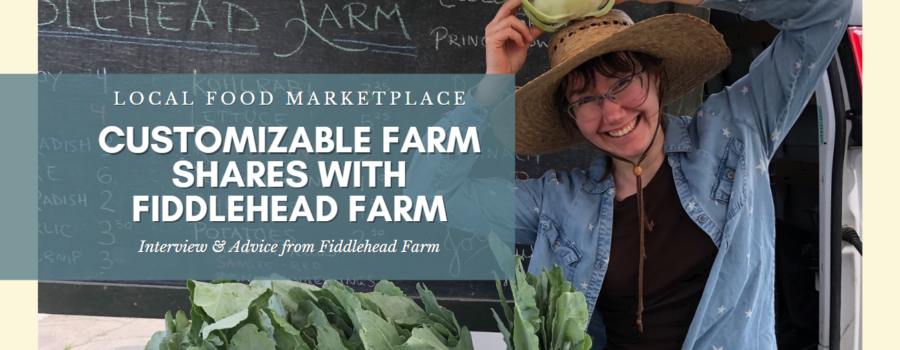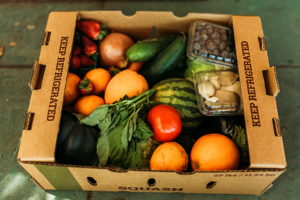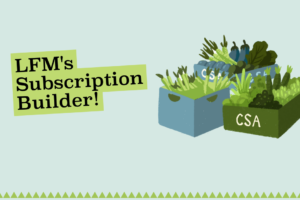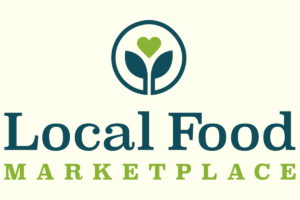How Fiddlehead Farm Uses LFM’s Software to Sell Customizable CSAs
For CSA farmers, finding technology to support their unique needs can be a challenge. We recently sat down with Heather Coffey of Fiddlehead Farm to talk about how LFM helps her offer customizable CSAs all year long to families in Ontario.

Heather Coffey of Fiddlehead Farm
LFM Customer Profile: Fiddlehead Farm
-
-
- An organic vegetable farm in Prince Edward County, Ontario
- Founded by Stephanie Laing and Heather Coffey in 2012
- Grows over 50 varieties of vegetables on 11 acres with a small team of staff
- Provides farm shares to 300 CSA members
-
Fiddlehead Farm is committed to promoting a sustainable food system by following organic practices, as well as committing to offering seasonal vegetables to its CSA members all year long. As Heather puts it, “We feed people year-round because people eat year-round.”
Creating Customizable CSAs with LFM’s Subscription Builder
Why Customize?
One of Heather’s priorities for selling local food online is a platform that can accommodate Fiddlehead Farm’s unique CSA format. With the help of LFM’s newest Subscription Builder software features, the farm is able to give CSA members the power to fully customize the items in their farm share.
“Customizable subscriptions are a no-brainer for me,” says Heather. “[Fiddlehead Farm’s CSA members] are making the commitment to local and the commitment to eating what’s in season, so I can at least give them the choice of everything that’s in the garden.”
Subscription Builder: How it Facilitates Customizable CSAs
Heather walked us through the step-by-step process of using Subscription Builder and how it helps her sell shares and support her farm’s mission of a more accessible model for local food.
Each week, Heather puts together a box of produce worth around $25 or $35. A few days before members pick up their shares, they have the option to add, remove, or replace certain items in the share. LFM’s software will then adjust their price accordingly. This is important to Heather.
“I want them to pay for what they’re getting. And I don’t want them to pay for anything they’re not getting. Subscription Builder allows us to ensure that we are only charging members for the vegetables they’re getting, and not penalizing them for wanting something different or for not wanting as many vegetables this week. We grow food and I want it to be eaten.”
The Process: How to List Customizable CSAs for Sale
Each week, Heather goes out into the field to list what’s for sale this week. “I list things on my clipboard — sometimes I take my phone to update it live but usually I just write it on my clipboard first. LFM automatically fills all the leftover inventory from the prior week, and then I scroll through the list to see what inventory I need to adjust for the current week.”

Customers are able to edit the items in their weekly subscription from Fiddlehead Farm.
LFM makes it easy to keep inventory up-to date: “All the products I have listed are already there. The products are already listed from last week if I didn’t sell them all. So it’s really easy to update on a weekly basis what is actually available for my customers.”
Next, Heather sets up her weekly farm share in Subscription Builder. “The software shows me the total value of the items going into the shares. Sometimes I edit the value because I want to keep my shares at $25 or $35 a box. Then I just say ‘create orders’ and the system just puts all the vegetables into people’s carts for them.
“Every week I fill the basket with what I think is the best of the garden. I love the control I have for filling those baskets. It means that I can rotate different crops through to make sure members get a good taste of the fields throughout the season.”
The Process: What the Customer Sees
Once Heather choses what’s in the box each week, she uses Subscription Builder to provide full flexibility for her 300 CSA members.
“And then customers have whatever time I’ve specified to edit what’s in their box. They can use the pencil to change the number of products, they can use the trash can to take something out, and then they can click on continue shopping to add other items into their cart.”
Specific LFM Features that Fiddlehead Farm Loves
Heather shared with us a few reasons that LFM stood above the competition when it comes to selling local food online and running her customizable CSA program.
1. A Price Point That Doesn’t Punish Growth
Heather appreciates LFM’s straightforward pricing system, where we never charge a percentage of sales fee.
LFM’s business model makes sense from my perspective. You build the platform, I pay for it on an annual basis. I get the software and the volume of my members or sales doesn’t change what you’re providing me. And I really appreciate that LFM is not charging me a percentage cut of my sales, which is brutal and so true of most other platforms. That’s very important to me.
Heather also finds LFM’s help documentation for customers quite useful. “I’ll have a question, and in a couple of clicks I’ll be like, ‘Yes! This is it!’. And that’s really good.”
“You’ve got a really amazing online support manual, which makes it much easier to go in and answer my own questions and figure out how things work. There are lots of screenshots, which helps.”

A veggie box from Fiddlehead Farm!
2. A Supportive Team
“One of the things I really like about LFM is that it’s a small tech support team—It’s not like I’m talking to ten different people all the time. It’s an established platform, there’s not crazy bugs to deal with. You guys know what you’re doing, you know how to do it.”
3. Common Goals
Heather sees shared goals between Local Food Marketplace and her own farm.
“So much of our farm is based on efficiency, what makes sense, and what’s simple to do. It feels like LFM’s approach to running an online system is very similar to my approach to running a small farm. It just makes sense.”
4. Control Your Own Data
Heather appreciates using a flexible, customizable platform that truly feels like her own. “I have control. I can do pretty much everything.”
Having access to sales data and reporting is also hugely helpful in making decisions from season to season. “The platform provides the sales data and information we need to modify our production based on what people are actually eating.”
Because at the end of the day, “we don’t want to produce more, we want to produce better.”
Expanding to Other Markets

Planting at Fiddlehead Farm.
LFM’s unique inventory management capabilities have also allowed Fiddlehead Farm to expand its sales to wholesale markets.
“LFM has really provided me with a more professional way to go about selling wholesale.
The same inventory I’m listing for CSA is available for wholesale orders. This was a really big win for us—We have not had a solid wholesale system yet, and there are a number of local restaurants who want local food. I’m happy to help them get it, provided we have a system in place.
I’m happy with the system and the way it’s working, so I feel confident to take on those extra restaurants, which I didn’t feel capable of until joining LFM. So it really boosted our ability and confidence in pursuing other sales opportunities as well.”
Heather’s Advice for Transitioning to a New Software Platform
For Heather, “the transition to LFM was a no brainer.” If you’re considering changing your software platform, feel free to contact us for a free consultation. And read on for Heather’s advice.
Firstly, try to plan ahead so that you’re onboarding before your busy season, not in the heart of summer.
Secondly, set up a FAQ page for your customers. Local food shoppers will have a range of tech knowledge or experience with shopping online. To help her customers shop more smoothly, Heather set up an online FAQ. “I’m in the field, so I’d like to give my customers all the tools to answer any questions they have on their own.”
Finally, plan some office time for your first few months “live.” There will always be a learning curve for both you and your customers when settling into a new online system. Setting aside some time early on to really set things up the right way can make all the difference.
Heather advises, “The more your can get to your customers answers before they ask the question the better!” This is where communication via emails and an online FAQ come in. Now that Fiddlehead Farm is fully setup in LFM, Heather is impressed by how few emails she gets from customers. And she doesn’t have to spend too much time online either.
“The actual time I spend using the LFM portal is maybe three hours a week. It’s mostly working out the details of what I want to include in my veggie box that ties up my time. Once I get to the input stage, it’s nice and quick!”
Ready for a local food software solution?
Get your FREE Demo!
Looking for more ways to grow your business and save time? Check out some free resources for farmers and food hubs:
-
-
- Read about how LFM helps one food hub work with over 50 producers:
- “What helps is that LFM is organized in a way that as producers, we list inventory ourselves, set prices, and describe our own products. We maintain the transparency of sourcing—you can see where every product comes from and customers value that.” –Kate Donald, Stout Oak Farm
- Looking to save time? Here’s how to gain 20 hours a week.
- Check out our free Guide to CSA Retention
- Want to keep up with all things Local Food Marketplace? Join our email list!
- Read about how LFM helps one food hub work with over 50 producers:
-




